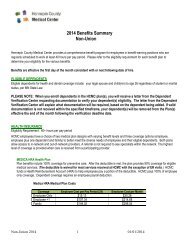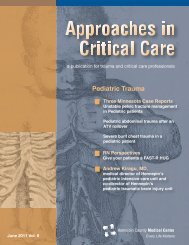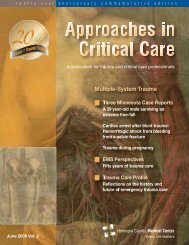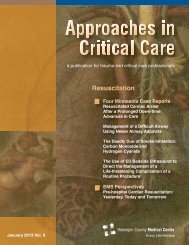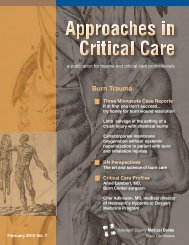Ischemic Stroke - Hennepin County Medical Center
Ischemic Stroke - Hennepin County Medical Center
Ischemic Stroke - Hennepin County Medical Center
Create successful ePaper yourself
Turn your PDF publications into a flip-book with our unique Google optimized e-Paper software.
EMS Perspectives<br />
__________________________________<br />
EMS Perspectives: Acute <strong>Stroke</strong><br />
Paramedics from <strong>Hennepin</strong> <strong>County</strong> <strong>Medical</strong> <strong>Center</strong><br />
transport a potential stroke patient.<br />
_____________________________________________<br />
by Robert Ball, EMT-P,<br />
<strong>Hennepin</strong> Emergency <strong>Medical</strong> Services, <strong>Hennepin</strong> <strong>County</strong> <strong>Medical</strong> <strong>Center</strong><br />
Acute stroke, or cerebral vascular<br />
accident (CVA), is the third leading<br />
cause of death in the U.S. Only heart<br />
disease and cancer (all types combined)<br />
have a higher mortality. Over<br />
780,000 new or recurrent strokes occur<br />
each year or roughly one every 40<br />
seconds. <strong>Stroke</strong> is the single largest<br />
cause of disability with over 4 million<br />
survivors; about 90 percent of those<br />
have at least some neurological deficit.<br />
History: <strong>Stroke</strong> treatment and EMS<br />
Historically, emergency medical services<br />
(EMS) has considered stroke to<br />
be a “life-threatening condition” but in<br />
the past it has been a threat that<br />
could not be mitigated. This tended to<br />
leave EMS at odds with other health<br />
care disciplines, as we would often<br />
find ourselves responding emergently<br />
to a patient who had an onset of stroke<br />
symptoms up to 24 hours earlier.<br />
The concept of stroke as a “brain<br />
attack” with definitive methods of<br />
treatment began in the mid-1990s, as<br />
ischemic stroke patients were treated<br />
with tPA and other “clot-busting” drugs.<br />
The limitations were great, however;<br />
patients with a symptom onset of<br />
greater than three hours were not<br />
good candidates for thrombolytics<br />
because necrotic areas had a higher<br />
risk of hemorrhage after this point.<br />
Also, guidelines dictated that treatment<br />
could not begin without ensuring<br />
the patient was indeed having an<br />
ischemic stroke and not a cerebral<br />
hemorrhage, which could be worsened<br />
by thrombolytic drugs like tPA.<br />
The narrow window of opportunity to<br />
provide an effective treatment made<br />
EMS a key stakeholder in reducing<br />
symptom onset to treatment time.<br />
Even so, the assessment necessary<br />
in the emergency department to ensure<br />
the patient was a suitable candidate<br />
for treatment resulted in a daunting<br />
challenge for providers, as some<br />
assessments were time-consuming.<br />
Since then, treatment for acute stroke<br />
has become more refined, including<br />
the use of intra-arterial administration<br />
of tPA at the site of the thrombus and<br />
mechanical clot retrieval devices.<br />
Such refinements in treatment have<br />
increased the window of treatment<br />
Approaches in Critical Care | December 2008 | 13





